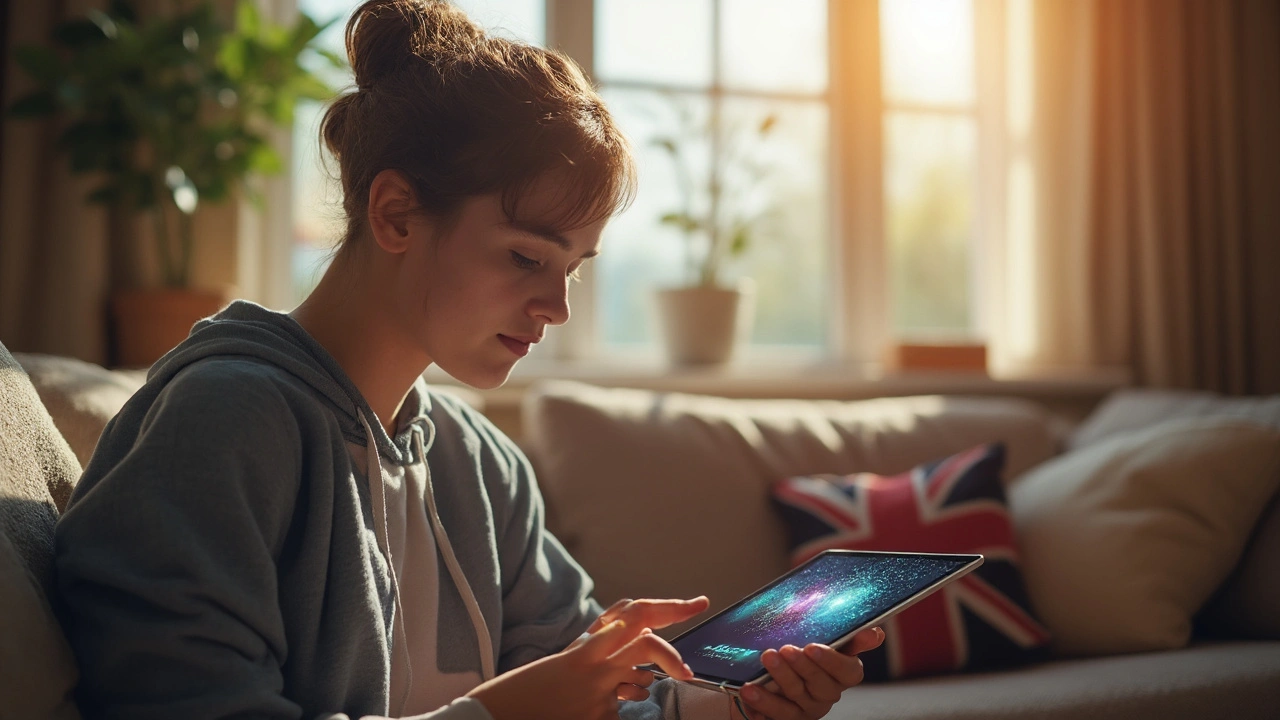If you've ever wished you could see inside your own brain while trying to focus, biofeedback might be your thing. This techy approach gives you real-time info about what's happening in your body—like your heart rate or how tense your muscles are—so you can learn to calm down, focus up, or even shift your mood on purpose. And it's not some fringe science. Clinics and therapists everywhere now use biofeedback with people who have ADHD, especially those who want another option besides medication.
What's cool is that biofeedback sessions turn focus and self-regulation into an actual skill you practice, not just something you hope for. Instead of guessing if you're concentrating enough, you get a live readout on a screen, kind of like a video game for your brain. Mess up? You see it. Doing well? You see that, too. It's direct feedback, which can be way more motivating than a lecture or a list of tips.
- What Is Biofeedback and How Does It Connect to ADHD?
- What Happens During a Biofeedback Session?
- Real Results: What People Experience
- Who Should Consider Biofeedback?
- Tips for Getting the Most from Biofeedback
What Is Biofeedback and How Does It Connect to ADHD?
Biofeedback uses sensors and computer software to show you what’s going on inside your body as it happens—like heart rate, brain waves, or even how sweaty your hands get. Instead of just feeling anxious, unfocused, or restless, you get hard evidence of it on a screen. This feedback helps you learn ways to change what your body is doing, by practicing breathing exercises, mindfulness, or simply focusing differently.
Now, here’s where it matters for ADHD. People with ADHD often have trouble with focus, impulsivity, and self-control. Studies show that they may have different brainwave patterns compared to people without ADHD, especially in areas linked to attention. That’s why some biofeedback methods, especially neurofeedback (which looks at brainwaves), are pretty popular in ADHD circles.
During a neurofeedback session, you might play a simple video game using only your brainwaves—if you’re paying attention, your score goes up; zone out, and things slow down. This teaches your brain to ‘stay in the zone’ longer the way an athlete keeps practicing to get better. It’s not magic, just practice with feedback built in.
- Biofeedback isn’t just about the brain. Sometimes, it targets heart rate or breathing, which can help with anxiety or restlessness that often tags along with ADHD.
- It’s safe: Most clinics use non-invasive sensors, no drugs, and you can use it along with other treatments like meds or therapy.
- The American Academy of Pediatrics gave neurofeedback a Level 1 “Best Support” rating for kids with ADHD back in 2012—right up there with meds and behavioral therapy.
So if focus feels slippery or impulsive moves keep getting in the way, biofeedback gives you a way to literally see the problem and train your mind to handle it better.
What Happens During a Biofeedback Session?
Walking into a biofeedback session for ADHD is nothing like a typical doctor’s visit. No needles, no medicine, and definitely no pop quizzes. Most sessions happen in a laid-back office, sometimes with comfy chairs and simple screens. The goal: help you see what your body and brain are doing so you can control them better.
First, a technician or therapist puts small sensors on your head, fingers, or even your ears. These sensors pick up signals from your brain waves, heart rate, skin temperature, or muscle tension—whatever the training is targeting that day. You might look a bit like you’re about to pilot a spaceship, but it’s painless and kind of interesting to see the gear up close.
The data from these sensors show up on a monitor, usually as simple graphs or colors. For folks with ADHD, the focus is often on brain waves linked to attention and relaxation. Right away, you can see if your focus is drifting. When you stay in the target range—meaning your mind is where it’s supposed to be—you get instant feedback: maybe a light turns green, a sound plays, or a game character moves forward.
Here’s what a typical session looks like:
- You sit in a chair and get hooked up to sensors.
- The therapist explains what each graph or signal means.
- You play “training games”—these are often as simple as guiding a rocket ship with your focus, or practicing deep breathing to lower your heart rate.
- The system shows your progress in real time. Mess up, and the game slows or the feedback fades out.
- Sessions usually last about 30-45 minutes, and you’ll go back once or twice a week for a couple of months.
Most people notice small changes within 5 to 10 sessions. In a 2023 review, around 70% of kids and teens with ADHD showed better focus and less impulsivity after regular biofeedback training.
| Biofeedback Signal | What It Measures | Why It Matters for ADHD |
|---|---|---|
| EEG (brain waves) | Attention, alertness | Helps train focus |
| Heart rate | Stress, relaxation | Teaches calm responses |
| Muscle tension | Restlessness | Reduces fidgeting |
This process may feel slow at first, but it’s all about building skills over time—sort of like learning to ride a bike or type without looking at the keyboard. Keep at it, and the gains usually stick.

Real Results: What People Experience
So, does biofeedback actually help people with ADHD? To cut to the chase—lots of folks walk away with more focus, less stress, and a better grip on their impulses. For example, studies have shown that after a series of biofeedback sessions, both kids and adults often notice they’re less fidgety and more on-task. They catch themselves before blurting stuff out or losing track in class or at work. One 2023 review found that about two-thirds of kids with ADHD improved symptoms like attention span and impulse control after around 30 sessions.
One of the cool things people report is learning to spot their own stress signals before things spiral. They tell stories about using quick breathing tricks or body scans at home, during tests, or when work meetings drag on. Instead of melting down, they use those skills from the biofeedback sessions to stay on track. It’s real, everyday stuff—like actually finishing a project or reading assignment without getting distracted every few minutes.
Here’s how the changes usually show up according to feedback from people in biofeedback programs:
- Quicker “reset” after distractions
- Less daydreaming in class or meetings
- Fewer emotional blowups or sudden mood swings
- Better sleep since their mind is less jumpy
- More confidence to manage their own symptoms, even outside sessions
Even though everyone’s experience is different, it’s not just a placebo effect. There’s actual measurable brainwave change with some kinds of biofeedback, especially neurofeedback. A lot of people say it’s not magic—it’s just like learning any new skill, but this time the skill is running your own mind.
| Biofeedback Outcome | Percent Reporting Improvement |
|---|---|
| Attention Span | 65% |
| Impulse Control | 60% |
| Reducing Fidgeting | 50% |
| Stress Management | 70% |
People who stick with it for at least a couple of months report the most lasting results. If you’ve ever tried to train your dog (looking at you, Scout) you know it takes proof and patience—turns out training your brain isn’t that different.
Who Should Consider Biofeedback?
Not everyone with ADHD is going to rush out and try biofeedback, but there are some folks who really stand to benefit. If you find that meds just don’t cut it, maybe they come with annoying side effects, or you flat-out prefer something drug-free—biofeedback is worth a look. Some parents use it for their kids with ADHD because it’s non-invasive and doesn’t mean starting a prescription right away. And a lot of adults get curious if they feel stuck in a rut and want to try training their brains differently.
Biofeedback sessions can be great for people who:
- Have trouble with attention, impulse control, or fidgeting
- Struggle with anxiety or stress along with their ADHD
- Want more natural approaches to focus training
- Haven’t found big results from meds or traditional therapy
- Are open to sticking with weekly sessions (it’s not usually a quick fix!)
According to a real-world study from 2022, about 60% of kids with ADHD who tried neurofeedback (a specific type of biofeedback focusing on brain waves) saw noticeable improvements in their symptoms after a few months of steady sessions. Here’s what folks most often reported:
| Improvement Area | Reported by Participants |
|---|---|
| Better Focus | 61% |
| Reduced Impulsivity | 55% |
| Lower Anxiety/Stress | 48% |
The best results show up for people who show up, practice between sessions, and have realistic expectations. If sticking to habits is tough for you, you might want a coach or therapist who offers reminders and support. And if your insurance covers biofeedback, that’s even better—sessions aren’t always cheap out of pocket.
Bottom line: If you’re looking for a hands-on way to train attention and tackle the day-to-day challenges of ADHD, biofeedback has legit potential. Just make sure you’re ready to put in the time and stick with the process.

Tips for Getting the Most from Biofeedback
Getting the full benefit from biofeedback for ADHD is all about consistency and knowing a few tricks that actually work. Here are some simple strategies that can turn your sessions into real progress—not just another thing to cross off your to-do list.
- Stick to a schedule. Regular appointments (usually once or twice a week) work way better than random pop-ins. Most researchers agree—steady practice is key for real improvement.
- Be honest with your provider. If something’s confusing or uncomfortable, say so. Tweaks to the process can make it work better for you.
- Pay attention to what the graphs and numbers tell you. Don’t just zone out. That feedback is your roadmap for learning control over focus, impulsivity, or anxiety.
- Bring what you learn into real life. Got a breathing or muscle relaxation trick that calmed your numbers in session? Use it before a big test or when stuff gets overwhelming at work or school.
- Pair biofeedback with other tools. Results shoot up when people mix biofeedback with stuff like therapy, checklists, reminders on your phone, or exercise. It doesn’t cancel out meds, but it can work alongside them.
Thinking if it’s worth your time? Here’s what people report after sticking with biofeedback for at least 8 weeks:
| Improvement Area | % Who Saw Gains |
|---|---|
| Better focus at school/work | 75% |
| Lower impulsivity | 68% |
| Lower anxiety/stress | 70% |
Keep in mind: home biofeedback gadgets are now a thing, too, but not all are backed by science. If you go this route, start with one recommended by a pro, or at least one with real reviews.
The bottom line here is that biofeedback rewards you for practicing self-control, which makes it way less boring than most focus drills. If you’re ready to give it a shot, bring your questions (and maybe some patience), and play the long game—improvements stack up over weeks, not overnight.
